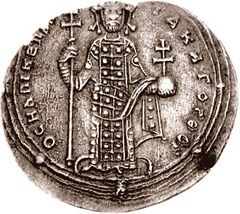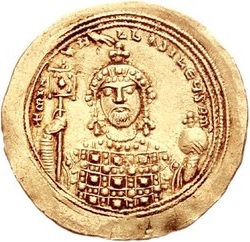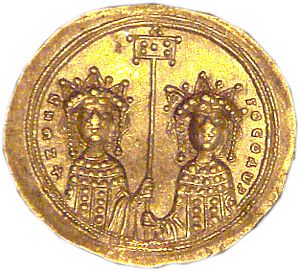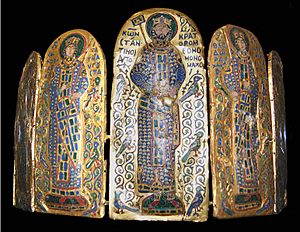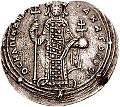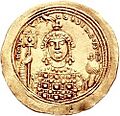Zoë Porphyrogenita facts for kids
Quick facts for kids Zoë Porphyrogenita |
|
|---|---|
| Empress and Autocratess of the Romans | |
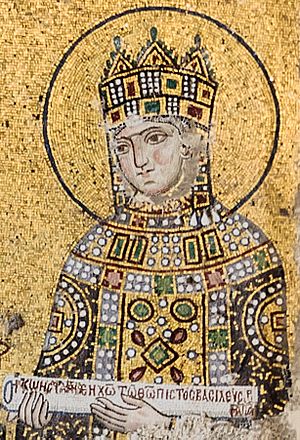
Mosaic of Zoë at the Hagia Sophia
|
|
| Byzantine empress regnant | |
| Reign | 21 April – 12 June 1042 |
| Coronation | 21 April 1042 |
| Predecessor | Michael V Kalaphates |
| Successor | Constantine IX and Theodora |
| Co-regents | Romanos III (1028–1034) Michael IV (1034–1041) Michael V (1041–1042) Theodora (1042–1050) Constantine IX (1042–1050) |
| Born | c. 978 Constantinople (now Istanbul, Turkey) |
| Died | 1050 (aged 72) Constantinople |
| Burial | Constantinople |
| Spouse | Romanos III (1028–1034) Michael IV (1034–1041) Constantine IX (1042–1050) |
| Issue | (adopted) Michael V |
| Dynasty | Macedonian |
| Father | Constantine VIII |
| Mother | Helena |
Zoë Porphyrogenita (meaning "life" in Greek; born around 978 – died 1050) was a powerful Byzantine Empress. She ruled from November 11, 1028, until her death in 1050. For a short time, from April to June 1042, she ruled the empire on her own. She also shared power with her sister, Theodora.
Zoë was born when her father, Constantine VIII, was a co-emperor with his brother, Basil II. Basil died in 1025 when Zoë was 47 years old. Her father then became the sole Byzantine Emperor. Since he had no sons, Constantine wanted one of his daughters to marry and continue the family line. Zoë, who was 50, married Romanos Argyros. They became emperor and empress the day after her father died.
Zoë and Romanos III had a difficult marriage. Romanos died in his bath in 1034. Zoë married her new partner, Michael, on the same day Romanos died. Michael was crowned Emperor Michael IV the next day. In 1041, Zoë was asked to adopt Michael's nephew, Michael Kalaphates, because Michael IV was very ill.
When Michael V became emperor, he quickly sent Zoë away from the capital. This made the people angry, and they started a revolt. The revolt removed Michael V from power and made Zoë and her sister Theodora joint empresses. After ruling together for two months, Zoë married a former friend, who became Emperor Constantine IX. She gave him much of the power, but she remained an important empress. Zoë died eight years later, at the age of 72. During her time, the Roman army became weaker, and the Turks began to enter eastern Anatolia.
Contents
Early Life and Marriage: 978–1028
Zoë was called Porphyrogenita, which means "born into the purple." This title was given to children born in the capital city while their father was the reigning emperor. She was the second daughter of Constantine VIII and his wife Helena. Her father became co-emperor when he was only two years old in 962. His brother, Basil II, who was the main ruler, did not allow his nieces to marry any Byzantine nobles. This was to prevent their husbands from claiming the imperial throne. As women, Zoë and her sisters could not hold state power themselves. Their only way to influence things was by choosing a husband, who would then gain authority through the marriage. Because of this, Zoë lived a quiet life for many years in the imperial women's quarters, called the gynaeceum.
As a princess, Zoë was considered a possible bride for the Holy Roman Emperor, Otto III, in 996. Another group of envoys came in 1001 to choose Otto's bride from Constantine's three daughters. The oldest, Eudocia, had scars from smallpox. The youngest, Theodora, was not considered attractive. So, the envoys chose the beautiful 23-year-old Zoë. Basil II agreed to this. In January 1002, Zoë traveled with the envoys to Italy. But when their ship reached Bari, they learned that Otto had died. Zoë had to return home.
When Basil II died, Constantine VIII became the sole emperor. His rule lasted less than three years, from December 15, 1025, to November 11, 1028. Zoë had another chance to marry in 1028 when envoys from the Holy Roman Empire arrived in Constantinople. They proposed an imperial marriage. However, Constantine and Zoë refused when they found out the groom, Henry, son of Conrad II, was only ten years old. Constantine decided that one of his daughters must marry a suitable noble to continue the ruling family.
The first person considered was a respected noble named Constantine Dalassenos. He was a former governor of Antioch. The emperor's advisors wanted a weaker ruler they could control. They convinced Constantine to reject Dalassenos, even after he had already been called to the capital. Romanos Argyros, the city prefect of Constantinople, was the next choice. Theodora refused to marry Romanos. She said he was already married (his wife had to leave her marriage to allow Romanos to marry into the imperial family). She also argued that they were too closely related to marry. So, Constantine VIII chose Zoë to be Romanos's wife. Zoë and Romanos married on November 10, 1028, in the palace chapel. The next day, Constantine died, and the newlyweds became the new emperor and empress.
From Romanos III to Michael V: 1028–1042
Zoë had lived in the same restricted palace quarters with her sister for years and had grown to dislike Theodora. Zoë convinced Romanos to appoint one of his own men to watch over Theodora's household. Soon after, Theodora was accused of trying to take the throne. First, with Presian in 1030, and then with Constantine Diogenes in 1031. Zoë accused her of being part of the plot. Theodora was then forced to stay in the monastery of Petrion. Zoë later visited her sister and made her take religious vows.
Zoë really wanted to have a child to continue the Macedonian family line. Almost immediately after marrying Romanos, the 50-year-old Zoë tried very hard to get pregnant. She used charms, amulets, and special drinks, but nothing worked. This failure to have a child caused problems between the couple. Soon, Romanos refused to share a bed with her. Romanos also limited his wife's spending and paid her little attention.
Zoë became very angry and frustrated. She became interested in a low-ranking servant named Michael. She openly showed her interest in him and talked about making him emperor. Romanos heard these rumors and spoke to Michael, but Michael denied the accusations.
In early 1034, Romanos became ill. On April 11, Romanos was found dying in his bath.
Zoë and Michael married on the same day Romanos III died. The next day, they called the Patriarch Alexios I to crown the new emperor. The Patriarch at first refused, but a payment of 50 pounds of gold changed his mind. He then crowned Michael as the new emperor, who ruled as Michael IV until his death in 1041.
Zoë thought Michael would be a more loving husband than Romanos, but she was wrong. Michael IV was worried that Zoë might turn against him, just as she had with Romanos. So, he kept Zoë out of politics and gave all power to his brother, John the Orphanotrophos. Zoë was again kept in the palace gynaeceum and watched closely. The unhappy empress tried to plot against John, but she failed.
By 1041, it was clear that Michael IV was dying. John the Eunuch wanted to make sure he kept his power. He made Zoë adopt Michael, who was the son of his and Michael IV's sister. On December 10, 1041, Michael IV died. He refused to see his wife, who begged to visit him one last time. His nephew Michael V was then crowned emperor.
Michael V had promised to respect Zoë, but he quickly sent her away to a monastery on Principus, an island in the Sea of Marmara. He accused her of trying to kill him. She was forced to cut her hair short and join a religious order. This treatment of the rightful heir to the Macedonian family caused a large uprising in Constantinople. Michael V, desperate to keep his throne, brought Zoë back from Principus and showed her to the people. But his demand that he continue to rule with her was ignored. On April 19, 1042, the angry crowd revolted against Michael V. They supported not only Zoë but also Theodora.
A group led by Patrician Constantine Cabasilas went to the monastery at Petrion. They wanted to convince Theodora to become co-empress with her sister. Theodora was used to a life of religious quietness and refused. She sought safety in the convent chapel. But she was carried by force back to the capital. At a gathering in Hagia Sophia, the people brought a very angry Theodora and declared her empress along with Zoë. They were both crowned on April 21. Michael V was forced to hide in a monastery.
Ruling with Theodora and Constantine IX: 1042–1050
Zoë immediately took power and tried to send Theodora back to her monastery. But the Senate and the people demanded that the sisters rule together. As her first act, Theodora was asked to deal with Michael V. Zoë wanted to forgive and free Michael, but Theodora was firm. She first promised Michael's safety, but then ordered him to be removed from power and to live the rest of his life as a monk.
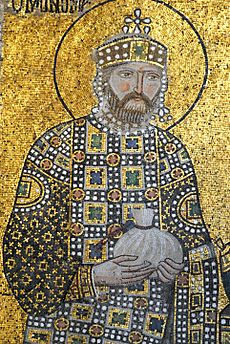
Officially, Zoë was the senior empress. Her throne was placed slightly in front of Theodora's at all public events. But in reality, Theodora was the main force behind their shared government. The sisters worked together to run the empire. They focused on stopping the sale of public jobs and on making sure justice was fair. While some historians said their joint rule failed, others stated that they worked hard to fix the problems from earlier reigns.
Theodora and Zoë appeared together at Senate meetings and held public audiences. But it soon became clear that their shared rule was under stress. Zoë was still jealous of Theodora and did not want to run the empire herself. However, she would not let Theodora handle public business alone. The court began to divide, with groups forming to support each empress. After two months of growing arguments, Zoë decided to look for a new husband. This would prevent Theodora from gaining more influence. According to the rules of the Orthodox Church, her next marriage, her third, was the last one she was allowed.
Her first choice was Constantine Dalassenos, who had been her father's first choice for her husband back in 1028. He was brought to meet the Empress. But during their talk, his independent and strong manner displeased Zoë, and he was sent away. Her next choice was Constantine Atroklines, a court official who was already married. He died mysteriously a few days before the wedding was planned, possibly due to his wife.
Zoë then remembered the handsome and polite Constantine Monomachos, another person she had known before. They married on June 11, 1042. Patriarch Alexios did not take part in the ceremony, as he refused to officiate a third marriage for either of them. Constantine was crowned by the patriarch the next day.
Zoë got more than she expected when Constantine decided to bring his close friend, Maria Skleraina, to his new position. He not only brought her to court but insisted that he be allowed to publicly share his life with her and that she receive some official recognition. The 64-year-old Zoë did not object to Skleraina having a special place at court. Skleraina was given the title of sebaste, which ranked below Zoë and Theodora. She was also called mistress or empress, like them. At official events, Skleraina stood right behind the sisters.
However, in the eyes of the public, Constantine IX's special treatment of Skleraina was a scandal. This led to a popular uprising by the people of Constantinople in 1044. The revolt came very close to harming Constantine, who was taking part in a religious procession. The crowd was only calmed when Zoë and Theodora appeared on a balcony. They reassured the people that they were safe.
It is said that Zoë was very beautiful. Michael Psellos, a historian, wrote that "every part of her was firm and in good condition." Zoë knew she was beautiful and used it to her advantage. To keep her youthful look, she had many creams and treatments made in the gynaeceum. She was said to have experimented to make them work better. She had a special room in her palace where perfumes and ointments were always being made. Psellos reported that her face looked young even when she was in her sixties. Zoë died in 1050, at the age of 72.
Images for kids
-
Histamenon coin showing Basil II and Constantine VIII, holding a cross
-
A Hagia Sophia mosaic of Constantine IX
See also
 In Spanish: Zoe para niños
In Spanish: Zoe para niños


